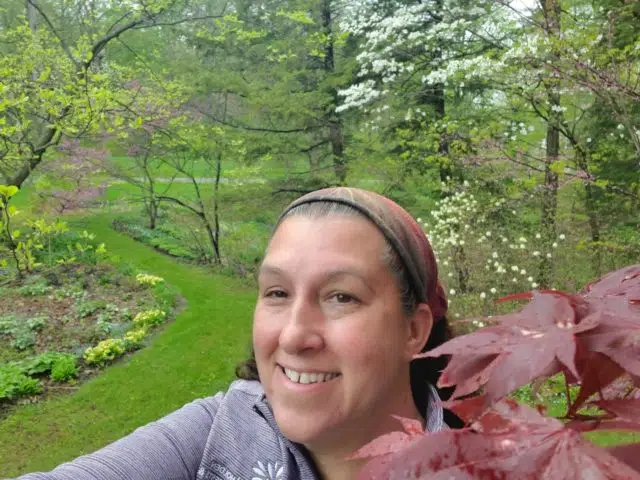
Renovating the Sand Prairie in the Myrtle S. Holden Wildflower Garden
It’s not quite the phrase from the musical, ‘Annie’, but it does convey the shock of the renovation work that has been taking place in the Myrtle S. Holden Wildflower Garden at the Holden Arboretum. If you’ve walked by the sand prairie recently you may have seen Horticulture staff digging in the sand like a bunch of prairie dogs – sand flying everywhere, roots being tossed into buckets destined for the compost pile – it was quite a production. The result should be an open sand habitat awash in blue sometime in May when the native wild lupines are decked out in bloom.

Natural History
The Wildflower Garden sand prairie is a habitat that represents the savanna and sand barren, sand prairie areas of Ohio. Many of these native plant communities were located along the shores of Lake Erie where the larger post-glacial lakes that resided in that same basin left behind sand beach ridges as the water receded. Lupinus perennis, sundial lupine, thrived in this low nutrient-high drainage dry sand environment that other species found hard to colonize. As a member of the pea family, the three-way relationship between lupine roots, bacteria, and fungus pulled nitrogen from the air and made it available in the soil. As time went on and the soil improved through this process, other species were able to move in. Natural fire events kept lupines and other native sand prairie species from being shaded by woody plant succession as it often swept through these communities and killed off species that were not tolerant. Until humans moved in.
Unnatural History
Although L. perennis is still found throughout most of its original range from New England to Minnesota, the population has been severely impacted due to habitat loss and fire suppression, making each plant community smaller and often much further apart. According to NatureServe, of the 30 North American states and provinces where it grows, it is ‘Apparently Secure’ in only 2 U.S. states and ranges from ‘Vulnerable’ to ‘Presumed Extirpated’ in all other places, including Ohio, where Ohio Department of Natural Resources currently lists it as “Potentially Threatened’.
Unintentional threats and consequences

Many North American native lupine species serve as good nectar and food sources for pollinators. Native to western U.S., Lupinus polyphyllus, bigleaf or garden lupine, is tolerant of a variety of growing conditions making it popular for landscaping in places other than where it grew originally. L. polyphyllus also easily hybridizes with other lupine species which is why it was crossed with at least three other species to create the desired ‘Russell Hybrid’ lupines. Unfortunately, in eastern North America, Lupinus polyphyllus and its hybrids planted in landscapes are both becoming invasive on their own and hybridizing with the eastern native Lupinus perennis creating new hybrid plants that native butterflies cannot recognize or eat. According to the Maine Natural Areas Program, it is likely L. perennis may currently be extirpated from the state and completely replaced by naturalized L. polyphyllus hybrids.
L. perennis, the only lupine species native to Ohio, is the single food source for the caterpillars of the Karner blue butterfly, Plebejus samuelis, a U.S. endangered species, and is the main food source of several other butterfly species critically imperiled in Ohio.

Why Renovate the Wildflower Garden Sand Prairie?
The sand prairie in the Wildflower Garden is not a naturally occurring plant community – the habitat was created by purchasing and installing many tons of sand and collecting and installing native propagules of appropriate species from Ohio natural areas. The positioning of the sand prairie in the middle of the tallgrass prairie and on two sides by lawn paths provides a constant threat of species trying to invade. It’s our job to keep that invasion at bay to preserve space for the lupines and the other short native prairie grasses and species that belong in this habitat. Recently we have been falling behind in the battle. To counter this problem, we held a group workday when many members of the Horticulture Department helped cut up pieces of sod like a cake, shook out the sand, dissected out any lupine roots or wanted native species and replaced them in the sand, then composted the matted roots of everything else. We’ve been slowly reclaiming the sand prairie over a few years, and think it is finally disturbed back to near its original size and the lupines are starting to multiply again.
Next steps will be to visit some natural areas around the state that are similar and to apply for permits to collect seed to gather or regather more diverse species to grow in this type of habitat. The goal will be to plant and encourage the species that belong in sand prairies while we keep balance in removing the species that are too aggressive or don’t belong in the educational story of this habitat. We hope to enhance our native plant collection’s educational value and beauty so we can continue telling these stories to help others learn and care about these fragile ecosystems.

Dawn Gerlica
Senior Horticulturist













